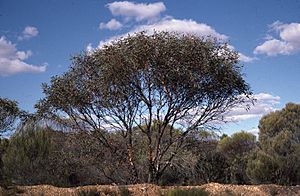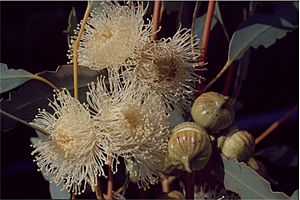Burracoppin mallee facts for kids
Quick facts for kids Burracoppin mallee |
|
|---|---|
 |
|
| Scientific classification | |
| Genus: |
Eucalyptus
|
| Species: |
burracoppinensis
|
The Burracoppin mallee, officially known as Eucalyptus burracoppinensis, is a special type of mallee tree. A mallee is a plant that grows with many stems from a large, woody base underground. This unique plant is found only in Western Australia. It has smooth, colorful bark, except for a small rough patch at its base. Its leaves are shaped like a spear, and its flower buds grow in groups of three. When it blooms, you'll see pretty white flowers. Later, it produces fruit shaped like a spinning top.
Contents
What Does It Look Like?
The Burracoppin mallee is a type of mallee that usually grows between 1 and 6 metres (3 to 20 feet) tall. It has a special woody swelling at its base called a lignotuber. This helps the plant regrow after a fire or damage.
Its bark is smooth and can be grey, coppery, or pink. But at the very bottom of the trunk, you'll find rough, loose strips of grey bark. Young plants and new shoots (called coppice regrowth) have dull green leaves. These leaves are egg-shaped to spear-shaped. They are about 70–100 mm (3–4 inches) long and 18–27 mm (0.7–1.1 inches) wide. Each leaf has a stalk called a petiole.
Adult leaves are also spear-shaped and are the same dull green on both sides. They measure about 60–115 mm (2–5 inches) long and 9–23 mm (0.4–0.9 inches) wide. Their petioles are 10–25 mm (0.4–1 inch) long.
The flower buds grow in groups of three. They are found on a single stalk called a peduncle, which is 7–30 mm (0.3–1.2 inches) long. Each individual flower has its own small stalk, or pedicel, which is 3–10 mm (0.1–0.4 inches) long.
Mature flower buds are flattened and globe-shaped. They are 16–30 mm (0.6–1.2 inches) long and 13–20 mm (0.5–0.8 inches) wide. The cap of the bud, called an operculum, is rounded and has a long, pointed tip. This cap is 11–23 mm (0.4–0.9 inches) long.
The Burracoppin mallee mostly flowers between August and November. Its flowers are always white. After flowering, it produces a woody, top-shaped fruit. This fruit is a type of capsule and is about 12–20 mm (0.5–0.8 inches) long and 15–25 mm (0.6–1 inch) wide.
How Was It Named?
The scientific name for this plant, Eucalyptus burracoppinensis, was first officially written down in 1925. This was done by two botanists, Joseph Maiden and William Blakely. They published their description in a scientific journal.
The second part of its name, burracopinensis, comes from the place Burracoppin in Western Australia. The ending -ensis is a Latin suffix that means "from a place" or "belonging to a country." So, the name tells us where this plant was first found or is common.
Where Does It Grow?
The Burracoppin mallee grows in sandy flat areas called sandplains. You can find it in different spots across the central and eastern wheatbelt region of Western Australia. This area includes towns like Ballidu, Bullfinch, Kondinin, and Marvel Loch.
Is It Endangered?
Good news! The Western Australian Government's Department of Parks and Wildlife has classified this eucalypt as "not threatened." This means it is not currently at risk of disappearing.
How Can We Use It?
The Burracoppin mallee grows slowly, but it's very tough. It can handle dry conditions, which means it doesn't need a lot of water. Because of this, people sometimes plant it in gardens or farms.
It can be used as an ornamental plant, meaning it's grown for its beauty. It also makes a good hedge or shelterbelt. These are rows of trees or shrubs that protect other plants or buildings from strong winds. It's a great choice for areas with low rainfall.



